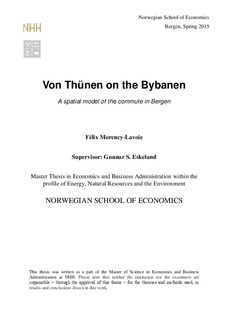| dc.description.abstract | The spatial model presented in this thesis explains the existing structure of Bergen and foresees how the city could evolve with the development of the light rails network (Bybanen). Many researches and policies were aimed at discouraging the use of cars. The approach taken here is not to force conversion of present automobiles drivers into collective transport users, but to make sure new commuters will predominately choose more sustainable modes of transport in the future. The key aspect is the appropriate location of new dense residential developments. Monocentric “compactness” does not necessarily result in a higher energy efficient city. Considering that further densification of Bergen Sentrum is not a feasible political/physical option, a light rail networks could lead, accordingly to the least commuting principle, to a denser city along the Bybanen route. As a strong sustainable symbol and a serious financial commitment, the Bybanen has the potential transform expectations and attitudes. Ultimately the Bybanen is a proficient strategy that will reshape the city; an opportunity to reduce GHG emissions and increase the societal welfare through (green) mobility.
Johannes von Thünen, the founder of spatial economics, has been a major direct and indirect inspiration in the construction of this model. A thorough reading of his magnum opus, The Isolated State, unearthed parts of his theories that have been either neglected or either entirely forgotten. For example the Thünian concept of land rent, which is more nuanced than the Ricardian Rent, can explain how a permanent infrastructure such as the Bybanen affects the structure of the city differently than an flexible bus network.
This research led to the creation of a commuting model true to the spirit of von Thünen. In addition, important contributions of his successors in location theory, urban economics and New Economic Geography have complemented the model in order to address urban challenges of the 21st century. | nb_NO |
